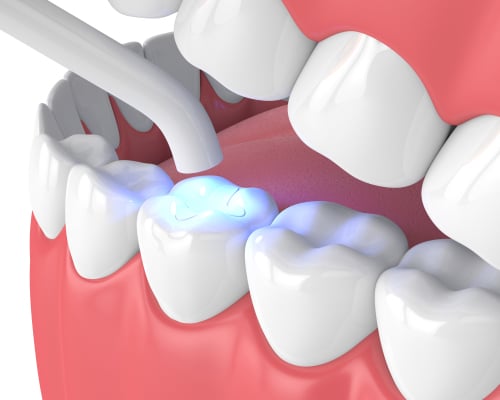Fillings
 What Is Dental Fillings?
What Is Dental Fillings?
There are several ways to fix a chipped, cracked or decayed tooth. Initially, your only recourse would be to go for a tooth extraction. But with the advent of new technologies in the field of dentistry, you no longer have to go for tooth removal. One alternative to extraction is dental filling, also simply known as filling.
Dental filling is a dental procedure that is usually recommended for people dealing with tooth cavities. Usually, your dentist will begin by removing the decayed portions. When that happens, a space will be opened up. It is this space that is filled using a special filling substance. Read on to learn more about dental fillings and how it works.
How Does A Dental Filling Work?
The process begins by your dentist applying a local anesthetic so as to numb the target area. This is a necessary measure because though a dental filling procedure is not a very invasive one, it still carries with it a degree of pain.
The next step involves cleaning of the decayed tooth and removal of the decay material. This is done by use of an air-abrasion instrument, a drill or a laser. For a more painless procedure, you are better off with a laser equipment. However, the ultimate choice will depend on how experienced and trained your dentist is, as well as the level of comfort offered by the equipment. The choice will also be determined by the extent of decay, as well as the kind of clinic where you go for the filling. High-end urban clinics will obviously use cutting-edge dental devices.
In the next procedure, the dentist tests the site of decay to determine whether all the decay has been eliminated. If satisfied, the dentist will clean the cavity using antiseptic solutions. This is important in preventing further damage that may be caused by any bacteria that could still be lodged in your teeth.
Cleaning is a delicate process, especially if the decay had built up near next to the nerve pulp chamber. In this case, your dentist might have to protect the root nerves by inserting a liner that is made of composite resin or ionomer. After all the filling procedure has been done, the next step is to polish the tooth.
If you opted for tooth-colored fillings, there could be other additional procedures. In this case, the dentist will move to apply the tooth-colored material in layers as soon as the decay is removed and the site is properly disinfected. These layers will then need to be hardened, using a special type of light. Again, the layering procedure is quite complicated and will require patience on your part and diligence on the part of your dentist. Once the layers have been set in, the composition is then modelled to the right level of your teeth. Any excess material is removed and for maximum results, the final restoration is polished.
Benefits Of Dental Fillings
1. Remedy for tooth decay.
2. Cost effective as some can last upwards of 15 years.
3. Some filling materials release fluoride that further protects your teeth.
4. Most filling materials are designed to match the appearance of your teeth.
5. Dental fillings strengthen your teeth structure and prevent any further infection.
Types Of Dental Filling Material
1. Silver-Amalgam Fillings
This kind of filling is the most popular. It is made up of various minerals where 50 percent consists of silver, copper, tin and zinc, and the other 50 percent is made up of mercury. Silver-amalgam fillings are especially lauded for their strength and relatively cost-effective.
They are also especially durable, able to last for up to 15 years and do not come with threats of blood or saliva contamination. Most dentists recommend it for its ease of setting up. On the flip side, silver-amalgam fillings are not very aesthetically appealing so they beat the whole idea of going for a cosmetic dental procedure.
However, you can use it for the less-visible teeth. This filling material is also known to be very responsive to changes in temperature, being able to expand or contract alternatingly, thereby putting your teeth at risk of cracking. The alternating heating and cooling could also cause bacterial buildup between the gaps created, thereby contributing to cavity growth.
2. Composite Fillings
These fillings are made up of a combination of plastic and resin material. It is usually applied when soft and then cured using a bright blue light. One of the most notable benefits of composite fillings is that you can easily get one that matches the appearance of your teeth.
However, a common drawback is that they do not last very long. You may need to have them replaced every five years.
3. Gold Filings
As expected, these fillings are characterized by their high cost and rarity. So, gold fillings are not the kind you will easily get done in any dental clinic near you.
Also, gold fillings require several dental appointments to have them firmly fixed. On the advantage side, these fillings are known for their strength and corrosion-resistance. Gold can withstand immense chewing pressure and they have a durability of up to 15 years.
Additionally, they also make for great aesthetics, compared to the more unsightly options like silver. The only precaution is to ensure the filling is not placed right next to a silver-amalgam filling. This is because the two substances can generate electric current, thereby leading to a galvanic shock.
4. Glass Ionomer-Fillings
Usually, Glass Ionomer-Fillings are recommended for children whose teeth size, shape and alignment are still changing. They are short-lasting, with a majority requiring replacement under 5 years of use.
They are also softer than most filling options, and cannot sustain heavy chewing pressure. And if you are looking for filling that matches the color of your teeth, Glass Ionomer-may not be your ideal option. However, they have a saving grace – they constantly release fluoride which protects the teeth of the wearer.
5. Ceramic Fillings
If you are looking for dental fillings that offer durability and cosmetic benefits in one package, then you are better off with Ceramic Fillings. These fillings are also fairly resistant to abrasion and tooth staining. They are mainly made up of porcelain and are fairly expensive.
Ceramic fillings are also very brittle so it has a tendency to break. You can make up for that by going for larger fillings, which could cost you more seeing as the area where they are placed will need to be made larger.
Conclusion
Dental fillings are some of the most recommended dental procedures. Not only are the fillings easier to set up, they are also fairly durable depending on the filling material you go for. Always consult with your dentist to uncover the right filling material for you.
